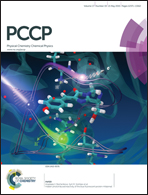A quantum biochemistry investigation of willardiine partial agonism in AMPA receptors†
Abstract
We employ quantum biochemistry methods based on the Density Functional Theory (DFT) approach to unveil the detailed binding energy features of willardiines co-crystallized with the AMPA receptor. Our computational results demonstrate that the total binding energies of fluorine–willardiine (FW), hydrogen–willardiine (HW), bromine–willardiine (BrW) and iodine–willardiine (IW) to the iGluR2 ligand-pocket correlate with the agonist binding energies, whose experimental sequential data match our computational counterpart, excluding the HW case. We find that the main contributions to the total willardiine–iGluR2 binding energy are due to the amino acid residues in decreasing order Glu705 > Arg485 > Ser654 > Tyr450 > T655. Furthermore, Met708, which is positioned close to the 5-substituent, attracts HW and FW, but repels BrW and IW. Our results contribute significantly to an improved understanding of the willardiine–iGluR2 binding mechanisms.


 Please wait while we load your content...
Please wait while we load your content...